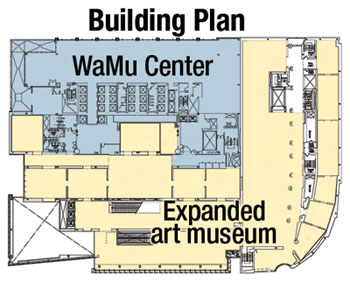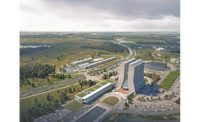 |
| Art museum will expand over time (top drawings) as bank vacates leased space. (Image courtesy of LMN Architects) |
The long-range expansion plan for the Seattle Art Museum Downtown is so ambitious and confusing, even to the trained eye, that SAM has its architect for tenant improvements creating a master document. It will contain just about everything that anyone working on the interiors in the future might need to know about the museum’s initial $86-million addition-renovation project.
The interior of the 12-story museum component was designed to accommodate the 25-year build-out—a series of two-story art galleries, offset and interlocking. But when SAM reopens next spring, it will only occupy four of the 12 floors. The other eight were redesigned and built as office space, with infill floors. The floors are being leased by Washington Mutual Bank, the museum’s partner in the 1.3-million-sq-ft development.
|
The serial use of the space was key to making the real estate deal work for the museum, which will use the rent to pay off its debt service on its share of the $370-million development. But the need to design for future conversions and design and build for the “day one” office occupancy complicated the project. It also created a need for the documentation, to ease the conversions down the line. As the museum raises funds and WaMu vacates, the museum plans to trash the “throw-away floors“ and convert the space for its use.  Click here to view diagrams
Click here to view diagrams
“We were hired to capture the as-built condition and the future configuration, to provide a series of documents for people to refer to as the years go by and changes are made,” says Sam Miller, a principal of LMN Architects, Seattle.
The binder contains as-built drawings, curtain wall shop drawings and information supporting the initial structural and mechanical systems. “It’s a fire hose of information,” says Miller.
The museum hopes to do the first conversion in 10 years.



Post a comment to this article
Report Abusive Comment